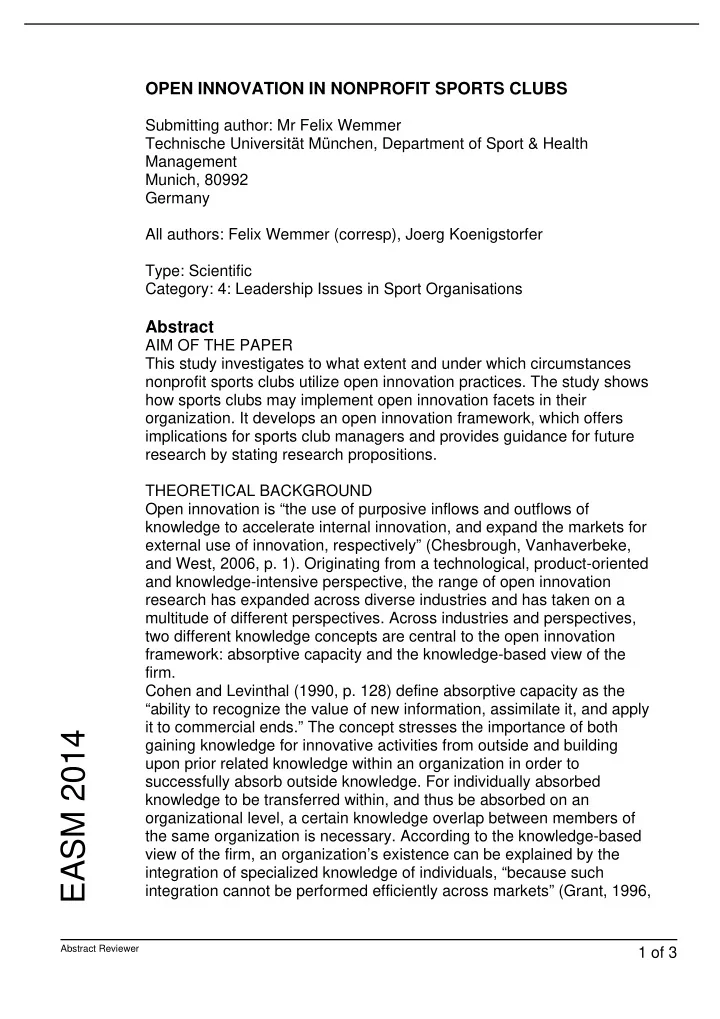

OPEN INNOVATION IN NONPROFIT SPORTS CLUBS Submitting author: Mr Felix Wemmer Technische Universität München, Department of Sport & Health Management Munich, 80992 Germany All authors: Felix Wemmer (corresp), Joerg Koenigstorfer Type: Scientific Category: 4: Leadership Issues in Sport Organisations Abstract AIM OF THE PAPER� This study investigates to what extent and under which circumstances nonprofit sports clubs utilize open innovation practices. The study shows how sports clubs may implement open innovation facets in their organization. It develops an open innovation framework, which offers implications for sports club managers and provides guidance for future research by stating research propositions.� � THEORETICAL BACKGROUND� Open innovation is “the use of purposive inflows and outflows of knowledge to accelerate internal innovation, and expand the markets for external use of innovation, respectively” (Chesbrough, Vanhaverbeke, and West, 2006, p. 1). Originating from a technological, product-oriented and knowledge-intensive perspective, the range of open innovation research has expanded across diverse industries and has taken on a multitude of different perspectives. Across industries and perspectives, two different knowledge concepts are central to the open innovation framework: absorptive capacity and the knowledge-based view of the firm.� Cohen and Levinthal (1990, p. 128) define absorptive capacity as the “ability to recognize the value of new information, assimilate it, and apply it to commercial ends.” The concept stresses the importance of both EASM 2014 gaining knowledge for innovative activities from outside and building upon prior related knowledge within an organization in order to successfully absorb outside knowledge. For individually absorbed knowledge to be transferred within, and thus be absorbed on an organizational level, a certain knowledge overlap between members of the same organization is necessary. According to the knowledge-based view of the firm, an organization’s existence can be explained by the integration of specialized knowledge of individuals, “because such integration cannot be performed efficiently across markets” (Grant, 1996, Abstract Reviewer 1 of 3
p. 119). Grant (1996) argues that knowledge is an essential element for achieving and maintaining a competitive advantage. Therefore, organizations are recommended to install a system for knowledge integration into the organization and knowledge transfers within the organization.� Based on these two knowledge concepts and Elmquist Fredberg, and Ollila’s (2009) conceptualization, we consider four dimensions of open innovation in sports clubs: (1) boundary permeability, (2) application and implementation of innovation practices, (3) managerial competencies, as well as (4) environmental and organizational factors. The first three dimensions are central to our framework of open innovations in sports clubs: they represent the core dimensions. Environmental and organizational factors determine the setting, in which such practices take place.� � RESEARCH DESIGN AND DATA ANALYSIS� The study used a qualitative approach using semi-structured interviews in order to develop a theoretical framework for open innovation in sports clubs. We conducted interviews with representatives from eleven sports clubs. The database ensuring a purposeful selection of sports clubs was provided by a municipal sports agency.� The interviews were conducted with one board member, mainly president or vice president, of each sports club. The interviews were audio- recorded and transcribed (88 pages). The content analysis of the interviews was conducted using deductive category application. The data was then reduced and solidified in a four-step process consisting of (1) paraphrasing the relevant material, (2) coding the paraphrases, (3) generalizing the paraphrases, and (4) integrating, deleting, and bundling of coextensive generalized paraphrases.� � RESULTS, DISCUSSION, AND IMPLICATIONS� The content analysis suggests a multi-dimensional framework for open innovations in sports clubs. It includes the three core dimensions as well as environmental and organizational factors. Within the core dimensions, we identified facets that drive (or hinder) the success of implementing innovations in sports clubs: competition and cooperation (boundary permeability), customer integration and distribution of tasks (application and implementation), commitment and qualifications (managerial EASM 2014 competencies), as well as size, infrastructure, financial situation, urban versus rural location, and the range of sports being offered to club members. The drivers and barriers are described using three examples of innovation implementation in sports clubs, that is, implementing a new business model, introducing a new organizational structure (or processes within the structure), and increasing diversity via new target groups.� The study contributes to the open innovation literature in three ways: (1) it introduces open innovation for services with high customer involvement levels in a nonprofit market; (2) it shows how nonprofit, volunteer-led organizations can be highly innovative via club and membership Abstract Reviewer 2 of 3
management practices; and (3) it describes how sports clubs make use of the coopetitive market structure, an elemental characteristic of sports markets. As the management of volunteer-led nonprofit organizations is inherently subject to time constraints, the integration of outside sources seems to be a beneficial and necessary step in order to create value through innovations. The propositions that were derived from our findings help researchers study the implementation of open innovation practices in nonprofit sports clubs. References Chesbrough, H., Vanhaverbeke, W., & West, J. (2006). Open innovation: Researching a new paradigm. Oxford: Oxford University Press.� Cohen, W. M., & Levinthal, D. A. (1990). Absorptive capacity: A new perspective on learning and innovation. Administrative Science Quarterly, 35, 128-152.� Elmquist, M., Fredberg, T., & Ollila, S. (2009). Exploring the field of open innovation. European Journal of Innovation Management, 12, 326-345.� Grant, R. M. (1996). Toward a knowledge-based theory of the firm. Strategic Management Journal, 17, 109-122. EASM 2014 Abstract Reviewer 3 of 3
Recommend
More recommend